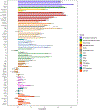The early-life exposome: Description and patterns in six European countries
- PMID: 30530161
- PMCID: PMC9946269
- DOI: 10.1016/j.envint.2018.11.067
The early-life exposome: Description and patterns in six European countries
Abstract
Characterization of the "exposome", the set of all environmental factors that one is exposed to from conception onwards, has been advocated to better understand the role of environmental factors on chronic diseases. Here, we aimed to describe the early-life exposome. Specifically, we focused on the correlations between multiple environmental exposures, their patterns and their variability across European regions and across time (pregnancy and childhood periods). We relied on the Human Early-Life Exposome (HELIX) project, in which 87 environmental exposures during pregnancy and 122 during the childhood period (grouped in 19 exposure groups) were assessed in 1301 pregnant mothers and their children at 6-11 years in 6 European birth cohorts. Some correlations between exposures in the same exposure group reached high values above 0.8. The median correlation within exposure groups was >0.3 for many exposure groups, reaching 0.69 for water disinfection by products in pregnancy and 0.67 for the meteorological group in childhood. Median correlations between different exposure groups rarely reached 0.3. Some correlations were driven by cohort-level associations (e.g. air pollution and chemicals). Ten principal components explained 45% and 39% of the total variance in the pregnancy and childhood exposome, respectively, while 65 and 90 components were required to explain 95% of the exposome variability. Correlations between maternal (pregnancy) and childhood exposures were high (>0.6) for most exposures modeled at the residential address (e.g. air pollution), but were much lower and even close to zero for some chemical exposures. In conclusion, the early life exposome was high dimensional, meaning that it cannot easily be measured by or reduced to fewer components. Correlations between exposures from different exposure groups were much lower than within exposure groups, which have important implications for co-exposure confounding in multiple exposure studies. Also, we observed the early life exposome to be variable over time and to vary by cohort, so measurements at one time point or one place will not capture its complexities.
Keywords: Children; Early life; Environmental exposures; Exposome; Pregnancy.
Copyright © 2018 The Authors. Published by Elsevier Ltd.. All rights reserved.
Figures







References
-
- Agier L, Portengen L, Chadeau-Hyam M, Basagaña X, Giorgis-Allemand L, Siroux V, Robinson O, Vlaanderen J, González JR, Nieuwenhuijsen MJ, Vineis P, Vrijheid M, Slama R, Vermeulen R, 2016. A Systematic Comparison of Linear Regression–Based Statistical Methods to Assess Exposome-Health Associations. Environ. Health Perspect 124, 1848–1856. 10.1289/EHP172 - DOI - PMC - PubMed
-
- Barrera-Gómez J, Agier L, Portengen L, Chadeau-Hyam M, Giorgis-Allemand L, Siroux V, Robinson O, Vlaanderen J, González JR, Nieuwenhuijsen M, Vineis P, Vrijheid M, Vermeulen R, Slama R, Basagaña X, 2017. A systematic comparison of statistical methods to detect interactions in exposome-health associations. Environ. Health Glob. Access Sci. Source 16, 74. 10.1186/s12940-017-0277-6 - DOI - PMC - PubMed
-
- Basagaña X, Pedersen M, Barrera-Gómez J, Gehring U, Giorgis-Allemand L, Hoek G, Stafoggia M, Nieuwenhuijsen MJ, Brunekreef B, Slama R, ESCAPE Birth Outcomes working group, 2018. Analysis of multicentre epidemiological studies: contrasting fixed or random effects modelling and meta-analysis. Int. J. Epidemiol 10.1093/ije/dyy117 - DOI - PubMed
-
- Bastian M, Heymann S, Jacomy M, 2009. Gephi: an open source software for exploring and manipulating networks. Int. AAAI Conf. Weblogs Soc. Media
-
- Buuren S. van, Groothuis-Oudshoorn K, 2011. mice : Multivariate Imputation by Chained Equations in R. J. Stat. Softw 45, 1–67. 10.18637/jss.v045.i03 - DOI

